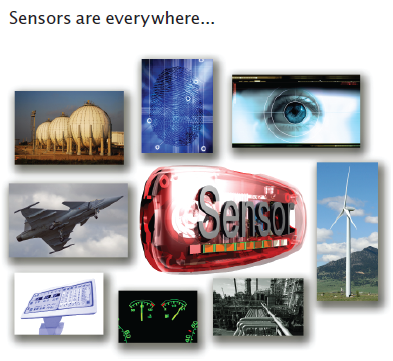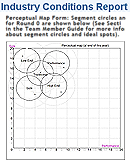Congratulations, you are now in charge of a sensor manufacturing company. Your firm was created when the government split a monopoly into identical competitors. When the company was a monopoly, operating inefficiencies and poor product offerings were not addressed because:
- Increasing costs could be passed onto customers; and
- Mediocre products would sell because customers had no other choices.
Although last year’s financial results were decent, your products are getting old, your marketing efforts are falling short, your production lines need revamping and your financial management is almost nonexistent.
Competition in the post-monopoly era means you can no longer ignore these issues. If you do, competitors with better products and/or lower prices will take your market share.

Sensors are devices that observe physical conditions. For example, the average cell phone contains dozens of sensors that allow it to interpret touch, spatial orientation, and signal strength. New sensor businesses are created every day in areas as diverse as security, aeronautics and biomedical engineering. You are in a business-to-business market, not a direct-to-consumer market; the sensors your company manufactures are incorporated into the products your customers sell.
1.1 The Industry Conditions Report
Each simulation industry is unique. The Industry Conditions Report describes, in detail, the business environment specific to your simulation, including customer buying criteria.

To view the Industry Conditions Report, log into your simulation and click the Reports link.
1.2 Management Tools
Here are the tools you need to run your company.
1.2.1 The Rehearsal Tutorial
Think of the Rehearsal Tutorial as a driving school for the simulation. The tutorial will show you ways to steer the company, including how to:
- Invent and revise products;
- Make marketing decisions;
- Schedule production and buy/sell equipment;
- Ensure your company has the financial resources it needs for the upcoming year.
The sample resources used for the Rehearsal, including its Capstone Courier and Industry Conditions Report, mirror those used in the actual simulation.
To access the Rehearsal, log in at the Capsim website and go to the Getting Started area.
1.2.2 The Capstone Courier
You and your competitors have access to the industry newspaper, the Capstone Courier. The Courier, described in Chapter 5, is a complete year-end report on the sensor industry including customer buying patterns, product positioning, manufacturing capacity and public financial information. Knowledge is power. If you have a question about your company, your customer or a competitor, start with the Capstone Courier.
The Courier’s Segment Analysis pages report Customer Survey Scores (detailed in Chapter 3) which play a large part in determining sales distributions. In general, the higher the score, the greater the sales.
The Courier displays “Last Year’s Results.” The Courier available at the start of Round 1 displays last year’s results for Round 0, when all companies were equal just after the monopoly’s breakup. The Courier available at the start of Round 2 will display the results for Round 1. As the simulation progresses and strategies are implemented, results among the competing companies will begin to vary.
The Courier is available from two locations:
- From the Capstone Spreadsheet, click Reports in the menu bar;
- On the website, log into your simulation and click the Reports link.
1.2.3 The Situation Analysis
Completing the Situation Analysis will enable you to understand current market conditions and how the industry will evolve in the next few years. It will assist you with your operational planning.
The Situation Analysis comes in two versions:
- Online interactive
- Downloadable PDF (pen and paper)
To access the Situation Analysis, log into your simulation and go to the Getting Started area.
1.2.4 Proformas & Annual Reports
Proformas and annual reports are specific to your company. Proformas are projections for the upcoming year. Annual reports are the results from the previous year.
The proformas will help you envision the impacts of your pending decisions and sales forecasts. The annual reports will help you analyze last year’s results.
Proformas are only available from the Capstone Spreadsheet’s Proformas menu. To access the annual reports:
- From the Capstone Spreadsheet, click Reports in the menu bar; and
- On the website, log into your simulation then click the Reports link.
1.2.5 The Capstone Spreadsheet
The Capstone Spreadsheet is the nerve center of your company where you formulate and finalize management decisions for every department. The spreadsheet comes in two versions:
- A Web Version that allows you to work via any Internet browser; and
- An XLS Version that runs via Microsoft® Excel®.
After you log into your simulation, the spreadsheet is available from the Decisions link.

1.2.6 Just in Time Information
In the spreadsheet decision areas, look for the flag symbol shown to the right. Clicking it will give you detailed information about the area you are viewing.
1.3 Company Departments
The Rehearsal Tutorial and Chapter 4 discuss company activities. You have four main departments or functional areas:
- Research & Development, or R&D
- Marketing
- Production
- Finance
Companies use the Capstone Spreadsheet to enter departmental decisions.
1.3.1 Research & Development (R&D)
Your R&D Department designs your product line. The department needs to invent and revise products that appeal to your customers’ changing needs.
1.3.2 Marketing
Your Marketing Department prices and promotes your products. It interacts with your customers via its sales force and distribution system. Marketing is also responsible for sales forecasts.
1.3.3 Production
Your Production Department determines how many units will be manufactured during the year. It is also responsible for buying and selling production lines.
1.3.4 Finance
Your Finance Department makes sure your company has the resources it needs to run through the year. The department can raise money via one year bank notes or 10 year bonds.
The department can also issue stock dividends, buy back stock or retire bonds before their due dates.
1.3.5 Plug-Ins
Plug-ins are different than modules. Plug-ins and their decisions have a greater overall impact on your organization.
For example, the simulation might include the Corporate Responsibility and Ethics plug-in, which presents you with an unexpected ethical dilemma. Group discussion and consensus is imperative because your decisions will affect your financial results.
Your simulation Dashboard will notify you if your simulation includes a plug-in.
1.4 Inter-Department Coordination
1.4.1 R&D and Marketing
R&D works with Marketing to make sure your product line meets customer expectations.
1.4.2 R&D and Production
R&D works with Production to ensure assembly lines are purchased for new products. If Production discontinues a product, it should notify R&D.
1.4.3 Marketing and Production
Marketing works with Production to make sure manufacturing quantities are in line with forecasts. Marketing’s market growth projections also help Production determine appropriate levels of capacity. If Marketing decides to discontinue a product, it tells Production to sell the product’s production line.
1.4.4 Marketing and Finance
Marketing works with Finance to project revenues for each product and to set the Accounts Receivable policy, which is the amount of time customers can take to pay for their purchases.
1.4.5 Finance and Production
Production tells Finance if it needs money for additional equipment. If Finance cannot raise enough money, it can tell Production to scale back its requests or perhaps sell idle capacity.
1.4.6 Finance and All Departments
The Finance Department acts as a watchdog over company expenditures. Finance should review Marketing and Production decisions. Finance should crosscheck Marketing’s forecasts and pricing. Are forecasts too high or too low? Will customers be willing to pay the prices Marketing has set? Is Production manufacturing too many or too few units? Does Production need additional capacity? Has Production considered lowering labor costs by purchasing automation?
1.5 Practice and Competition Rounds
Practice Rounds allow you to organize workflow among the members of your company. You will begin to compete against the other companies in your simulation, or, if you are in a Footrace competition, against a common set of computer-run companies.
Don’t confuse the Rehearsal Tutorial with the Practice Rounds! During the Rehearsal Tutorial, you are shown how to make decisions in a scripted environment. During the Practice Rounds, you can experiment with your decisions in a competitive environment.
After the conclusion of the Practice Rounds, the simulation is reset and the real competition begins. Now it’s time to drive your company to success! Companies compete for five rounds, with each round simulating one year in the life of your company.
1.5.1 Decision Audits
The Decision Audit is a complete trail of all team decisions. It will help you identify your decision-making strengths and weaknesses.
The audit is available from two locations:
- From the Capstone Spreadsheet, click Help in the menu bar; and
- On the website, log into your simulation then click the Decision Audit link.
1.6 Company Success
The board of directors, shareholders and other stakeholders expect you to make the company a market leader. Successful managers will:
- Analyze the market and its competing products;
- Create and execute a strategy; and
- Coordinate company activities.
Best of luck in running a profitable and sustainable company!